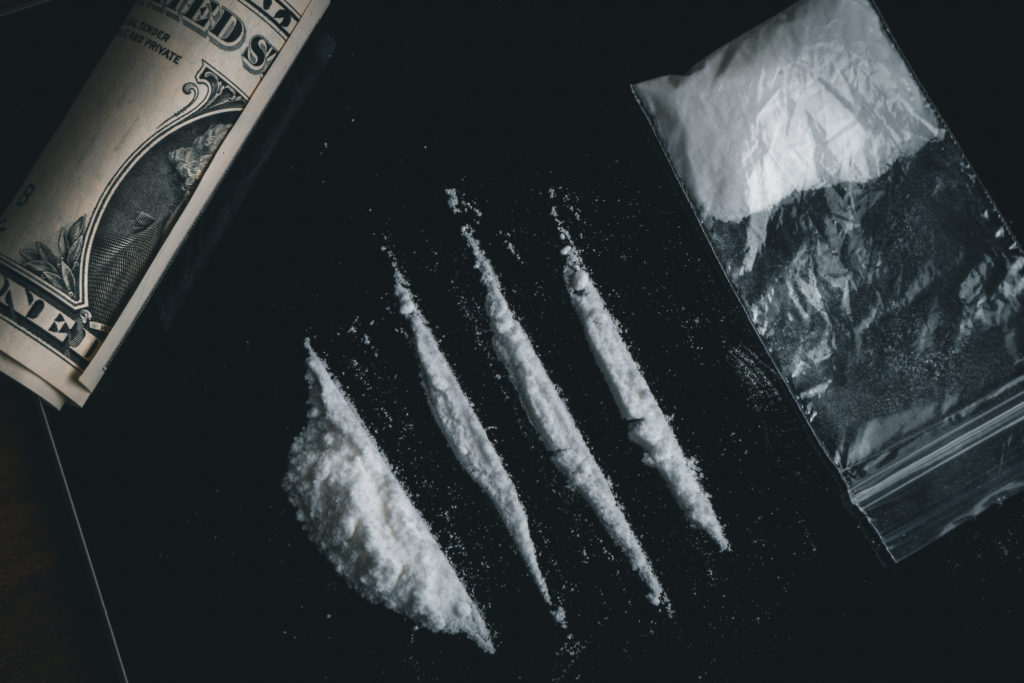Cocaine Side Effects
Cocaine, one of the most popular stimulant drugs in the United States, continues to be used and abused today. It is by far one of the top ten most abused drugs.
Popularly glamorized by many TV stars, movies, and the opulent lifestyles of “new money” artists since the1970’s, cocaine continues to put people of all walks of life at risk for drug addiction. Whether you casually use cocaine, know someone who abuses cocaine, or merely want to understand the popularity of this drug, it’s important to see the cocaine side effects and risks that can take place.
Where Did Cocaine Come From?
Before we understand cocaine side effects, let’s learn what cocaine is and how it got here.
Cocaine comes from an extraction of the leaves on the Coca plant. Coca (Erythroxylum coca) is a plant found naturally in the Andes mountain ranges of South America. Coca is not the same as cocoa, from which we know chocolate is made– it is an entirely different plant.
Over time and still today, it has become one of the biggest cash crops in the western South American region. However, the cocaine trade has come with much political and cultural detriment. Even in countries where it’s illegal to cultivate or process cocaine, like Columbia and Peru, thousands of struggling families continue to grow it in secret to keep making a living.

Coca: 5,000-Year-Old Plant Medicine
In a 1984 Cultural Survival Report on Coca and Cocaine, Cornell University researches explain the importance the Coca plant held with indigenous Latin American tribes. Long before other countries began soliciting Coca for cocaine drug production, peoples of the Andes mountains would use Coca leaves for ritual and health purposes.
Many farmers and high-altitude labor workers were known to chew dried leaves of the Coca plant to feel a mild anti-fatigue effect. The sensation would be similar to how we relate to caffeine today. Coca leaves and teas were also revered among natives for relieving pain, and stomach illnesses, healing ulcers, and easing other medical conditions.
Of course, the modern drug use of refined cocaine powder is much different than the historical ethnobotanical use of plants. Because of this, general scientific studies claim there is no medical value to cocaine. It remains an illegal, Schedule II drug with high risk for abuse in America.
Was Cocaine Ever Used Medically?
In the 1860s a German chemist studied cocaine extractions and discovered its numbing effects when placed in the mouth. From here, scientists started to theorize it could be a new anesthetic. The study of the substance kept going. Several doctors used it as a topical numbing agent for spinal issues. The use of cocaine during surgery was also recorded at this time and through the early 1900s.
Many people today know the history and widespread rumors about Sigmund Freud and his abuse of the drug. There is a list of other early researches who eventually became addicted to cocaine once they started taking it internally.
As the risks of cocaine addiction grew more apparent, it stopped being used in medical settings. Additionally, there was the growth of better and safer anesthetics, many that are still with us today.
Cocaine Side Effects in American Youth
Although at its peak in 1986, cocaine use among high schoolers seems to have decreased now. However, today it is not uncommon to hear about or see cocaine use among teenagers.
In a 2016 report, the average high schooler admitted it would be somewhat to extremely easy for him or her to obtain cocaine from someone they know personally. Luckily in this same report, nearly 45% of teens who were asked said they saw cocaine as a “high risk” drug, even if tried only once or twice. (p. 19 National Survey Results on Drug Use )
That said, with the rise of experimental drug use in teens and young adults, there continue to be coke users in every niche. Especially with the massive expansion of live entertainment and music festivals in the past decade or so, cocaine is sought-out and well known by many fun-seekers both young and old.
For this reason, it’s important to know all of the mild to severe cocaine side effects. If you or someone you know does consider or decides to try cocaine, be aware and avoid the possible damages. If the thought of cocaine use freaks you out, there are always safer ways to have fun in social party settings.
The Addiction to Cocaine

As a stimulant drug, cocaine is easily addictive. The main reason for this is because it delivers a large amount of dopamine to the brain.
The supply of dopamine to the brain from cocaine or other stimulant drugs is much higher than the brain is capable of naturally producing on its own. This is why, after only one or several uses of the drug, addiction is a legitimate risk.
If frequent use continues, an individual’s brain will begin to register the increased amount of dopamine from cocaine as “normal”. The human body is always trying to adapt to its conditions in order to survive. When there’s an abundance or lack of something, it signals the brain to compensate to the best of its ability to keep a steady balance. Therefore when the consumption of cocaine ceases, the brain needs to readjust back to its former dopamine levels. As a result, withdrawal can occur.
Psychological or Physical Cocaine Addiction?
Mental addiction to a substance is when a person feels the urge to recreate a pleasurable feeling or experience over and over. Not all drugs are addictive mentally (also known as psychologically addictive), but you can become mentally addicted to nearly anything. This includes cocaine. Cocaine is highly addictive psychologically, but it is mainly known for being addictive physically as well.
Physical addiction relates to the explanation of brain chemistry as mentioned above. With cocaine, since dopamine levels increase leading any cocaine user to become dependent on it, it’s considered physically addictive. If you find yourself or someone you care about being addicted to cocaine, find them a medical detox center to avoid dangerous withdrawal side effects.
Physical Cocaine Side Effects
There is a slight difference in cocaine side effects that can vary from person to person. The main factors that influence this difference are the natural build of the user, how sensitive they are to substances in general, the purity of the drug, and how much experience they have with stimulants.
Generally, both first-time users and longer-term abusers of cocaine gravitate towards the drug for the same thing. Being a stimulant, the use of cocaine releases a rush of dopamine to the brain, thus increasing specific activities.
Some people notice cocaine makes them more energized to complete tasks or increases their performance for work, partying, and socializing. On the other hand, because cocaine effects people differently, other users could experience the exact opposite. Especially in individuals who exhibit traits of an attention disorder, cocaine can make them mellow out. In such a circumstance, they feel calmer, demotivated, or sometimes even anti-social.
The user feels more alert, euphoric, aware, and energetic among other things. Physically, the person who uses cocaine experiences a list of common effects:
- Increase in heart rate
- High blood pressure
- A rise in body temperature
- Dilated pupils (center of the eye becomes enlarged)
- A temporary rush of exhilaration or feeling “invincible.”
- Constricted blood vessels
- Body twitches
- Tremors or shakes
Psychological and Emotional Cocaine Side Effects
In addition to the physical changes, a slew of mental and emotional cocaine side effects can appear as well. Depending on the person and their situation, these psychological effects can have either a positive or negative outcome.
Some people experience the total euphoric “high,” feeling on top of the world, noticing the enjoyable increased sensitivities to light, sound, and touch. On a standard lighter dose this usually lasts no more than thirty minutes. On more massive doses, however, these effects can remain present for longer.
If a person takes too much for the first time or doesn’t react well to the substance, their cocaine side effects can be entirely different. They may feel anxious, paranoid, or for the most part uncomfortable. Some even act out in violent behaviors while believing paranoid delusions, in extreme cases.

Signs of Cocaine Addiction
Cocaine side effects can take a different or drastic turn for the worse when facing a full-blown addiction. What once seemed to be an enjoyable or stimulating experience, now becomes an unfortunate dependency. There are symptoms of substance abuse regarding any drug addiction, but cocaine side effects of an addicted person can be seen through a few specifics.
The most stand-out sign to look out for is drug paraphernalia around the individual’s living space. It can become apparent when there are clear small baggies, white powder, short straws, or small mirrors and other flat surfaces for snorting cocaine off.
Aside from the obvious of finding the actual drug, physical signs can be any of the listed side effects including:
- Weight loss
- Hyperactivity
- Talkativeness
- Abnormal increase in confidence
- Excitability
- Dilated pupils
- Becoming socially withdrawn
- Nosebleeds, runny nose, sinus issues
- Financial difficulties, sometimes despite having a secure job or source of income
- Changes in behavior
- Unusual sleeping habits
- Change in appetite
- White powder on hands, face, clothing, or in the bedroom
- Increase in sexual interactions
- Mood swings
- Suspicious behavior
- Taking unusual risks or hanging out with risky crowds
- Carelessness for overall appearance
Long-Term Cocaine Side Effects from Coke Abuse
Cardiovascular
Long-term cocaine abuse can break your heart. In many addicts of crack cocaine especially, the cardiovascular struggles result in chest pains, increased risk for heart attack, and permanent strain on the heart. Higher rates of stroke and seizure is also a common long-term cocaine side effect.
Neurological
Overuse and abuse of cocaine can directly damage the brain. A lot of former cocaine addicts can have memory issues, movement disorders (such as Parkinson’s disease) and even develop a lack of impulse regulation.
Physical
One of the primary physical damages of long-term cocaine side effects happens to the nose and throat passages. The chronic snorting of cocaine or smoking crack can permanently harm the nasal canal, throat, mouth, and lungs. As a result, the person could have trouble breathing, frequent bloody noses, runny nose or sinus infections, and in awful situations, collapsed nose structure.
Liver damage, kidney failure, and stomach issues are other potential long-term cocaine side effects.
Crack users usually develop more negative respiratory issues. Breathing problems, asthma, lung infections, and COPD are most common.
Cocaine Side Effects: Mixing with Other Drugs
If cocaine combines with other drugs like alcohol, MDMA, or opioids, there can be even more severe permanent damages.
You should never mix stimulants with depressant drugs as they counteract each other and often succeed in a shutting down of the body’s functioning. That can be fatal by overlapping accidental overdose, cardiac arrest, coma, or death.
Although many people think using cocaine after a long night drinking will help them keep partying longer or harder, it’s probably the worst combination to mix coke and alcohol. The mixture of the two causes something called cocaethylene. Cocaethylene is a substance your body produces when these two drugs are both present in your body, even if taken at different times.
Having cocaethylene in the body can make you have seizures, liver failure, or cause a sudden heart attack. It is a danger that is possible even for healthy, younger individuals. Never mix coke with alcohol.
What to Do if You or Your Loved One has a Cocaine Addiction
Firstly, identify the problem and admit there is drug abuse present in your life. Here is the first step in getting help for addiction or searching for the right support for someone you care about.
When you are ready and willing, find a reputable treatment center that can help you through the first stages of recovery. Detox from sustained cocaine addiction can be a lifesaver, especially for heavy users. It is advised to go to a hospital or treatment center with medically supervised detox. This way, there is less risk of complications or adverse withdrawal symptoms.
Inpatient Rehab
The next best step is to commit to completing an inpatient treatment program. Here a person addicted to stimulants can gradually come off of the significant cocaine side effects with the safety and support they need.
Inpatient rehab centers allow you to be away from the stress of life for a little while to focus on getting sober. From there, you can learn new habits and tools to rebuild a drug-free life and continue to move forward after leaving recovery.
Support Groups
Support is crucial as the people who we interact with daily either build us up, keep us steady, or tear us down. Most successful recovering addicts swear by this, hence support groups like AA or NA are great options for living out long-term recovery.
Call for Help
Call the free Prevail Intervention Addiction Helpline to talk to a professional about anything related to addiction or recovery. Getting clean is possible, and we help thousands of families through the process. The time to end cocaine addiction is now, so contact us today.
Sources
Long-Term Effects of Cocaine Use – National Institute on Drug Abuse
Cocaine: What is the Crack? A Brief History of the Use of Cocaine as an Anesthetic
Coca and Cocaine Effects on People and Policy in Latin America

